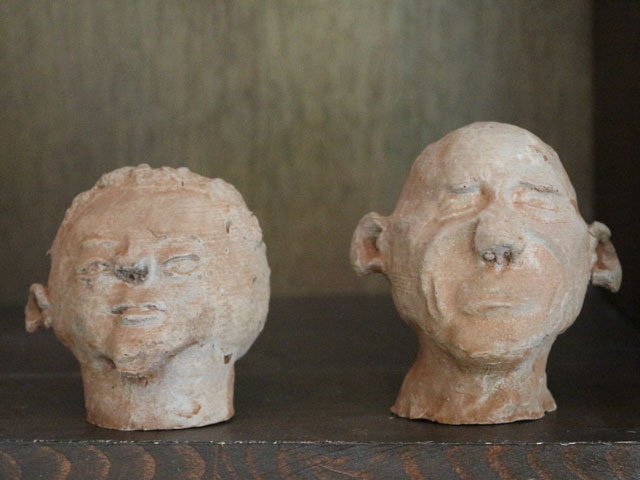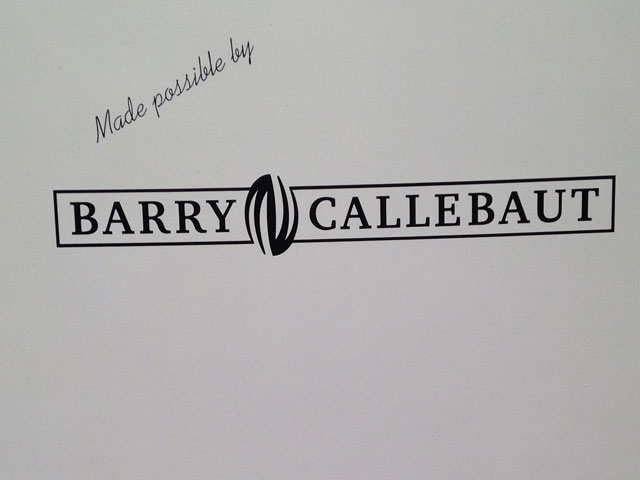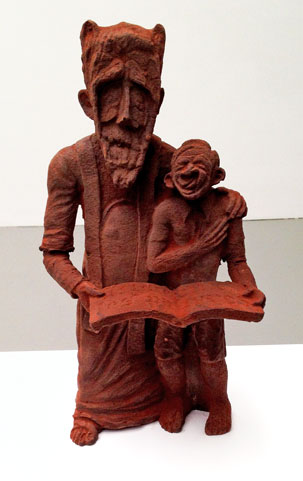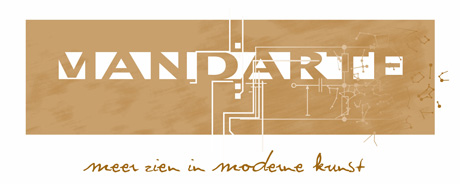 Renzo Martens and the Institute for Human Activities.
Renzo Martens and the Institute for Human Activities.
Diongo (links) en Manenga (rechts) staan bij ons in de kast. We bestelden ze al tijdens de Rotterdam Art Week in de stand van Fons Welters. Nu zijn we ze op gaan halen in de galerie in Amsterdam, waar de tentoonstelling op 2 mei j.l. geopend werd, onder de titel Renzo Martens and the Institute for Human Activities.
De koppen zijn 9 en 11 cm hoog. Ze zijn gemaakt van iets hards, gips misschien of gebakken klei, en ruiken naar chocola. Hun oppervlak is onmiskenbaar bestoven met cacaopoeder en als je ze vastpakt, blijft er wat van dat goed achter op je handen. Op de doosjes waar ze in verpakt zaten, in vetvrij grijs papier, hebben zij met zwarte viltstift hun naam geschreven en hun handtekening gezet.
Fons Welters vertelt ons dat de koppen dáár in Congo zijn gemaakt. Vervolgens werden er mallen van gemaakt in Europa. Hier worden daarvan nieuwe afdrukken gegoten, die wij nu gekocht hebben, en het geld gaat rechtstreeks naar de kunstenaars, die hun zelfportret voor ons en voor de cacaomarkt gemaakt hebben. Een van de hoofdsponsors is Barry Callebaut, 's werelds grootste chocoladefabrikant. Het bedrijf werd opgericht via een fusie tussen de Belgische onderneming Callebaut en het Franse Cacao Barry. De verwantschap Martens, België, Congo en Callebaut behoeft nauwelijks toelichting.

Gaat het hier om sculptuur of om ‘maatschappelijk verantwoord ondernemen’?
Renzo Martens richtte in 2012 het Institute for Human Activities op in Nederland, België en de Democratische Republiek Congo. De flyer van Galerie Fons Welters schrijft:
“Dit nieuwe instituut komt voort uit een zekere lacune die kan worden waargenomen bij veel recente geëngageerde kunst, waarbij bijvoorbeeld arbeidsomstandigheden, migratie en sociale onrechtvaardigheid worden onderzocht. Hoewel dergelijke werken kunstenaar en publiek bewust maken en mogelijkheden tot gelijkheid creëren in bijvoorbeeld Peru, de Parijse banlieues of Afrika, doen ze dat voornamelijk op een symbolisch niveau. Op een materieel niveau genereren dergelijke projecten vooral schoonheid en kennis en stimuleren ze de economie in die steden waar dergelijke interventies worden verkocht, getoond en besproken: Venetië, New York en Berlijn, en ja, ook in Amsterdam. Het Institute for Human Activities wil deze kloof doorbreken en juist op die plekken waar geëngageerde kunst zich op richt, ook materiële verandering teweeg brengen. (…)

Een groep plantagearbeiders maakt zelfportretten en sculpturen, onder begeleiding van de in Kinshasha woonachtige kunstenaars Mega Mingiedi, Eléonore Hellio en Michel Ekeba. Deel van het Curriculum zijn uitgebreide sessies, waarin de arbeiders over hun angsten en dromen voor de toekomst praten. Zo werken ze samen aan een kritisch begrippenapparaat om over hun beelden en kunst te praten. Mathieu Kasiama introduceerde bijvoorbeeld het woord fiofio dat in het Kikongo ‘iemand die ideeën in de wereld brengt’ betekent en nu wordt gehanteerd om ‘creatie’ aan te geven. De meeste van deze arbeiders verdienen niet meer dan een dollar per dag, hebben geen toegang tot schoon water, elektriciteit of sanitaire voorzieningen.
Zij hebben zich nu georganiseerd in de Cercle d'Art des Travailleurs dePlantations Congolaises (CATPC). De beelden die Kasiama, maar ook Mbuku Kimpala, Emery Mohamba, Daniel Manenga, Cedric Tamasala, Dionga Bismar, Jeremie Mabiala en Thomas Leba maakten, reflecteren hun levens, hun omgang met het mysterie van geld, dat sommige mensen uit het niets lijken te kunnen scheppen, en waar zij zelf niet genoeg van hebben om hun kinderen te voeden.
Hun dagelijkse belevingswereld en daarmee trauma’s, keren rechtstreeks terug in de beelden die zij maakten.”
En niet onbelangrijk is dan de conclusie:
“Door de toevoeging van emoties aan de chocolade gaan de potentiele inkomsten per
gram chocolade met duizenden procenten omhoog. De opbrengsten van de verkoop van deze multiples heeft als doel het Kritisch Curriculum zelfvoorzienend te maken.
Het Institute for Human Activities zorgt er zo voor dat de plantagearbeiders die niet in levensonderhoud kunnen voorzien met plantage arbeid, nu wel kunnen leven van hun artistieke visie op plantagearbeid.”
Dat alles is context. Over de kwaliteit van de sculpturen – die niet valt te ontkennen - wordt niet gesproken. Daar is het ook niet het moment voor. Eerst moeten we eten, zou Marx zeggen, vervolgens warme kleding en een dak boven ons hoofd. Veel later daarna komen pas godsdienst, filosofie en kunst. Is het toeval dat ‘Het Kapitaal’ juist deze maanden wordt voorgelezen op de grote thematentoonstelling van de Biënnale van Venetië?
Zie ook de website: http://www.humanactivities.org/
(Als u op de foto's hieronder klikt, ziet u een vergrote versie) {gallery}RenzoMartens{/gallery}
Op vrijdag 22 mei j.l. ontving ik de volgende tekst over het Institute for Human Activities van e-flux.com:
 The New Settlement, undisclosed location, Democratic Republic of the Congo. Photo: the Institute of Human Activities, 2015.
The New Settlement, undisclosed location, Democratic Republic of the Congo. Photo: the Institute of Human Activities, 2015.
Current exhibitions
www.humanactivities.org
In 2012, the Institute for Human Activities (IHA) started A Gentrification Program on a former Unilever plantation in Congo, 800 kilometers from Kinshasa, on a tributary of the Congo River.
For the first time since the IHA established its initial settlement three years ago, it is presenting three exhibitions entirely dedicated to its activities and the Cercle d'Art des Travailleurs de Plantations Congolaises (CATPC):
The Matter of Critique
May 1–June 7
KW Institute for Contemporary Art, Berlin
A Lucky Day
May 1–July 26
KOW, Berlin
A New Settlement
May 2–June 6
Galerie Fons Welters, Amsterdam
Unilever, well known for sponsoring Tate Modern's Unilever Series, founded its first palm oil plantation in 1911, after which Congolese inhabitants were coerced into forced labor. Today, few of the workers have access to clean water, electricity, or sanitation, and still produce the ingredients for Unilever's Blue Band.
In the summer of 2013, Canadian palm oil operator Feronia forced the IHA to leave its settlement and the communities with whom it had been working. From its New Settlement in exile, plantation workers continue the Critical Curriculum and are developing a critical apparatus to think through their fears, dreams, complicity and resistance, and the role of art. A new series of sculptures, made out of river clay, reflect upon the mystery of money—some people appear to create money seemingly out of thin air, even as the workers themselves do not have enough to feed their children.
The original clay sculptures of Mathieu Kasiama, Mbuku Kimpala, Emery Mohamba, Daniel Manenga, Cedrick Tamasala, Dionga Bismar, Jeremie Mabiala and Thomas Leba could not be exported, but have been scanned and transported digitally to Amsterdam, the world's biggest cocoa port. There, the sculptures are reproduced in the very cocoa that Congolese plantation workers have been generating for the global market for over a century.
By adding content, emotions, and critical thinking to the chocolate, the profits of the plantation workers increase by several thousand percent per gram of chocolate. In this way plantation workers, who cannot provide sustenance with plantation labor, are now able to live from their critical engagement with plantation labor.
During The Matter of Critique at KW Institute for Contemporary Art in Berlin, the IHA and CATPC are meeting with artists, collectors, cappuccino bar operators, activists and scientists, including Charles Esche, Ellen Blumenstein and Stefan Heidenreich, channeling the necessary capital, ideas, and critique to the Settlement in the Congolese rainforest. The IHA aims to learn from KW's experience as the anchor for Berlin-Mitte's redevelopment, thus providing lessons to make criticality productive in the Congolese rainforest.
In KOW, A Lucky Day, referring to a sculpture by Thomas Leba and Daniel Manenga, presents seven large chocolate sculptures. A New Settlement in Galerie Fons Welters shows the same large sculptures, in conjunction with video and photographic works documenting this journey.
The Institute for Human Activities asserts that even when art critically engages with global inequalities, it ultimately brings beauty, jobs, and opportunity to places like the Lower East Side in New York and Berlin-Mitte. To counteract this situation, the IHA has built a settlement in the Congolese rainforest where art can fully deal with its dependencies on these very inequalities, turn gentrification into a tool for economic justice, and recalibrate art's critical mandate.
IHA's recent exhibitions include Confessions of the Imperfect, Van Abbemuseum, Eindhoven, and Artes Mundi 6, Cardiff. Presentations were held at Tate Modern, London, Stedelijk Museum, Amsterdam, and other venues.
Support
The IHA is a research project at KASK – University College Ghent. The IHA is generously supported by Barry Callebaut, Mondriaan Fund, Amsterdam Fund for the Arts, Prins Bernhard Cultuurfonds, Prins Claus Fund, Outset Netherlands, BesteBuren, Akademie der Künste der Welt, Stedelijk Museum Amsterdam, Van Abbemuseum, De Hallen Haarlem, V2_ Institute for the Unstable Media, KOW Berlin, and Galerie Fons Welters.
I H A
e-flux
311 East Broadway
New York, NY 10002, USA
Lees ook het artikel van "de Correspondent" via deze link naar de Correspondent
